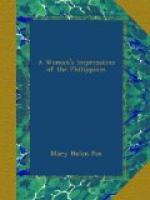But to return to typhoons. We had several more that year, and I began to feel that typhoons were terribly exaggerated in books. But in 1903 we had an object lesson that I do not care to repeat. We went through all the usual preliminaries of typhoon signals, drizzle and gust. It was, I believe, the tenth of June. I stayed up late that night, working, and noticed that the gusts were increasing. Just at midnight I laid down my pen and started to go to bed, when there came a blast that shook the house like an earthquake and made me decide to wait a while. For the next three hours the storm raged in a very orgy of gladness. It slapped over nipa shacks with a single roar. It ripped up iron roofing and sent it hurtling about the air. The nipa of my roof was torn off bit by bit, and the rain came in torrents. I used my mackintosh to cover up the books, and put a heavy woollen blanket over the piano. Then I held an umbrella over the lamp to keep the rain from breaking the chimney, and sat huddling my pet monkey, which was crazed with fear. The houses on either side were taller than mine, and for this little hollow it seemed as if all the iron roofing of the town had steered a direct course. The pieces came down, borne by the shrieking wind, and landed with rattle and bang. My house swayed at every gust. It seemed that the cross-beams in the roof moved at least a foot each way. The little lanterns that burn in front of the houses were blown out by the wind, and when I peered out there was nothing but the inky darkness, the howling of the wind, the thrashing of the cocoanut trees, and the thud of falling nuts. From my side window I could see the native family next door to me all on their knees in front of an image of the Virgin, and once, in a lull, caught the sound of their prayers.
The storm reached its greatest violence by half past one and subsided by about three, at which time I went to bed and slept till morning. In spite of my fear I could not help laughing at my two Filipino girl servants. They slept undisturbed through the earlier gusts, but when the roof went and the water came in, they awoke—disgusted. The oldest one said, “Mucho aguacero” (a heavy shower) and cast about for a dry spot. She didn’t find any at first, but she finally concluded that the corner where my bed stood was highest; lifting the valence, they disappeared.
Next morning Capiz presented a pitiful sight. Many of the great almond trees on the plaza were uprooted and the others dismembered. The little nipa houses were flat on the ground or drunkenly sprawling at every slant and angle. Even the best houses had suffered. The constabulary cuartel was absolutely wrecked. The Supervisor’s kitchen was gone, and his wife mourned for her dishes, which were scattered up and down the length of the street. The home of the scout officer was jruined. He and his wife had taken shelter under a stone wall, and been drenched for three or four hours. The young mangoes had been strewn on the ground, and there was no hope of that crop. Many of the cocoanut trees were broken off, and where this was not the case, the nuts had been whipped off. The banana trees were entirely destroyed. Altogether it was a sorry sight, and we all got out and walked about and viewed the ruins, just as we do for a cyclone at home.




